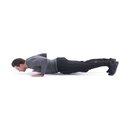Long-term health and strength require an investment in your body that might not pay noticeable dividends for weeks or months. It's scary, but true. Of course, it's no fun to keep looking in the mirror without seeing what you visualize when you close your eyes at night. When you feel yourself mouthing the words "It's not working," it can seem like the only options you have are drastic change or heading back to the couch.
If you're struggling to stay the course, don't abandon all hope and give up on fitness just yet. You might just need some guidance and wisdom from a few fit minds. Heed the advice of these professional strength coaches who have helped countless clients get fit for life.
Q. "What's your advice to those on the brink of abandoning their fitness goals?"
Tony Gentilcore: Set specific goals and temper expectations
- Name: Tony Gentilcore, CSCS
- Occupation: Co-founder of Cressey Performance.
- Website: tonygentilcore.com
It's been said that 25 percent of people who make a New Year's resolution have already fallen off the wagon after their first week. That number continuously grows with each passing week and month.
Some research nerds I've talked to have noted that more than 50 percent of people who make resolutions have already turned the page and forgotten all about it by six months in.
As a strength coach, I see numerous people attack their training goals with guns blazing, only to putter out within a few weeks for two main reasons. Their goals aren't specific enough, or they lack what I like to call "expectation management."
1. Goal specificity
Announcing that you're finally going to get fit on Facebook isn't specific enough. Just showing up at the gym and doing, um, something isn't specific enough. Sure, doing something is always better than nothing—I'd never downplay any form of exercise—but those arm circles with pink dumbbells aren't going to be enough to get fit, whatever that word means to you.

Setting quantifiable goals is my favorite tactic to motivate clients. A prime is example is when I have female clients focus on a specific goal like performing a single bodyweight chin-up. I prefer these types of goals over worrying about scale weight, which usually causes damaging mind games.
In my opinion, the amount of effort, hard work, and dedication required to perform a clean, full-ROM chin-up trumps anything done with pink dumbbells. Developing solid goals ignites a fire in my clients. Training with purpose and intent is vital to accomplish any fitness quest.
2. Expectation management
If you've never deadlifted before and set a goal to pull three times your bodyweight by the end of the year, you've almost inevitably set yourself up to fail. While you're at it, why not say you're going to win Mr. Olympia or arm-wrestle a grizzly bear, too!
Setting lofty goals is great, but they have to be realistic, and in most cases, incremental. My three-step plan to deadlift more weight would be this:
- Step 1: Learn proper deadlift form so your spine doesn't hate you.
- Step 2: Deadlift 1-2 days per week and build consistency.
- Step 3: Deadlift your bodyweight for reps.
The sky's the limit from there. If you make incremental goals and conquer specific markers, you'll almost always stay on task.
Dean Somerset: Commit to the long haul
- Name: Dean Somerset
- Occupation: Exercise physiologist; medical and rehabilitation coordinator for World Health Clubs.
- Website: deansomerset.com
I employ three methods to pull my clients off the ledge and bring them back into the gym with renewed focus and energy.
1. Take an overall healthy approach
Don't think of training as a means to lose weight. That mindset is unsustainable. Instead, view working out as a way to feel better. If you feel sluggish and slow during the work day, start your morning with a 10-20-minute walk or cardio session to loosen the joints and get your blood flowing. You don't learn to play basketball by launching three-pointers, so why would training be any different?
If you're lucky enough to have boundless energy at the end of the day, start lifting weights to increase sleep quality so you can wake up reenergized. It doesn't require hour-long sessions to see benefits either.
A 20-minute weight training workout can be very effective, and it doesn't have to incorporate a dozen different random movements to work.
Here's an example:
2. Treat training like an important errand
Make training part of your daily routine and set a trigger that reinforces its importance within your mind. As a trainer, I have a pretty hectic schedule that fluctuates daily. When I have a 12-hour day filled with clients, I schedule a training session for myself so I can unwind and restore the beat up tissues from walking on concrete surfaces all day.
If I have a break in the middle of the day, I schedule my training then so I can recharge and focus on my performance variables. If you can consistently remember to record and watch "Breaking Bad," you can make time to work out!
Every workout is an investment toward achieving fitness. It takes time, attention, and consistency to earn that elusive goal. Commit and you will succeed.
3. Value consistency more than intensity
Consider working out like saving for retirement. You won't get there with one paycheck. It takes time, attention, and most importantly, consistency. The fittest people I work with don't train the hardest every time, but they train the most consistently and remain focused.
You don't need to feel like you just went 10 rounds with Mike Tyson to have an effective workout. Just stay the course!
Lee Boyce: Give your body time to adapt
- Name: Lee Boyce
- Occupation: Owner of Boyce Training Systems.
- Website: leeboycetraining.com
My advice is to think in opposites. If you're frustrated with a lack of change from hard work in the gym, it may be beneficial to step back and remember that your body needs time to adapt.
If you're an out-of-shape adult male, think about how many years it took living sedentary on a bad diet to train the body to store fat, lose muscle, and lower its conditioning.
Reversing those effects won't happen in four weeks. It takes discipline, consistency, time, and patience to make an investment in your body pay off.
No pro-level bodybuilder in any federation ever said his road to success was speedy. I've yet to see a six-month prodigy heavyweight bodybuilder who went from scrawny to jacked in minimal time.
Start with these basic principles and build a foundation of fitness success!
Pro athletes know that rest is vital to growth. Rest easy, then work hard!
1. Walk more often
In this day and age, manual methods of transportation are scarce. Start walking to up your energy levels and possibly save money in the process.
2. Get more sleep
You'll likely feel more energized and less lethargic after getting quality rest. Sleep will also potentiate more results from your workouts. Shoot for roughly eight hours per night.

3. Eat more vegetables
Many vegetables, especially cruciferous vegetables, have anti-estrogenic properties. That's good for training purposes and promotes testosterone production.
4. Wake up early
An earlier bedtime and wakeup time can really change your day, because you'll have more time to get things done, before school or work. Training in the morning is underrated!
5. Eat breakfast
Your muscles are bereft of nutrients as you sleep, which can make you feel sluggish in the morning. Fuel your body and brain with quality food to start the day! Protein and fat are great at this time.
Todd Bumgardner: Find perspective in your goals
- Name: Todd Bumgardner, MS, CSCS
- Occupation: Co-founder of Beyond Strength Performance. Strength and conditioning coach and manual therapist at Ranfone Training Systems.
- Website: beyondstrength performance.com/todd-bumgardner-m-s
It takes a certain degree of perspective to succeed on a strength and conditioning quest. Just think of the word "quest." It implies traveling along an arduous path toward a worthy outcome. Most people are looking for something easier and quicker than that, and this is precisely why they fail to reach their goals.
Consider your current goals. Are they meaningful, or are they a cookie-cutter replica of someone else's goal? A goal that isn't attached to something deep and personal within you is a dead-end waiting to happen. It should hurt if you fail. If it doesn't, it won't drive you.
This is one reason why I favor strength goals. Aesthetic goals are notoriously fickle, because your outward appearance is often a poor measure of the actual changes happening in your body.
Sorry to be Johnny Raincloud, but in my experience as a strength and conditioning coach, it takes more than an abdominal sextuplet and walnut-demolishing glutes to power consistent progress over the long haul.
Expectations are also an issue. It's vital to remember that lasting results take time. A goal that's worth the effort will take months or even years to achieve. If you think it's going to happen overnight, you'll be sorely disappointed and find yourself on the treacherous, greasy downward slide away from achievement.
Examine what you've set out to attain and why you chose it. When you finish traversing the myriad possibilities, self-doubts, and half-truths, adhere determinedly to an aim that stirs your soul. When you find it, remain steadfast.











